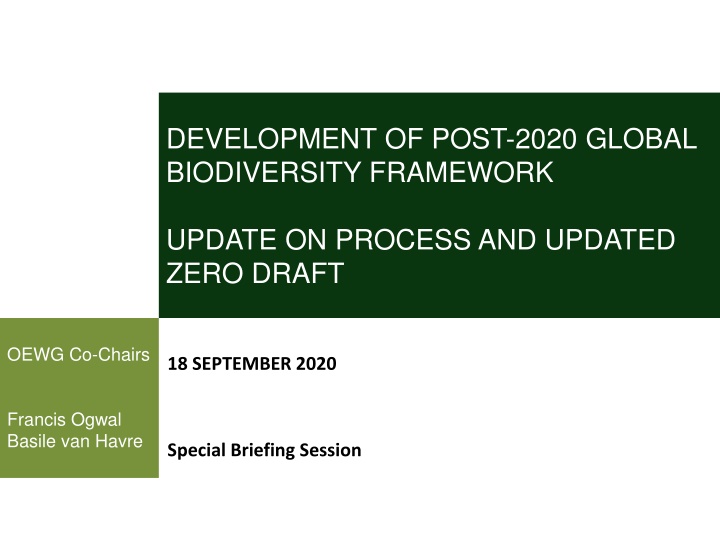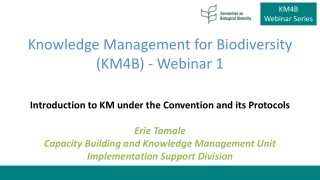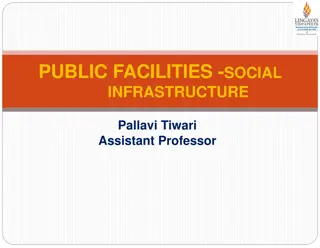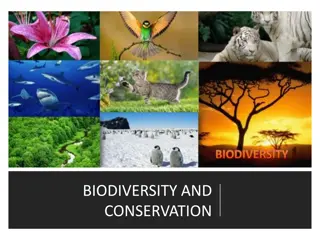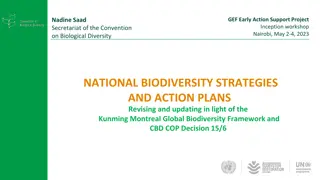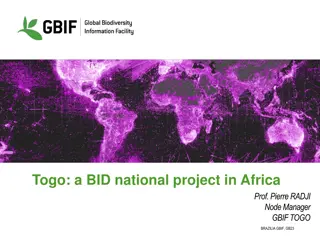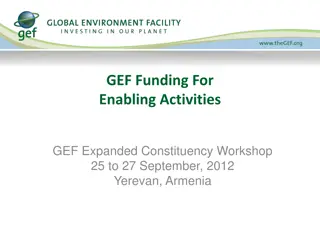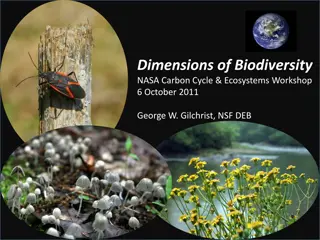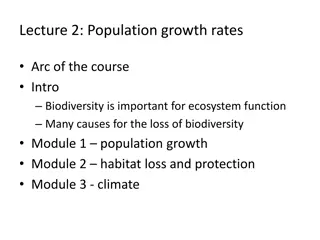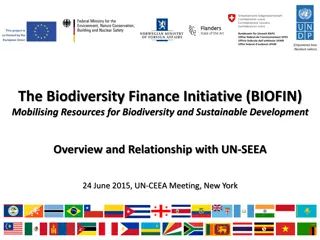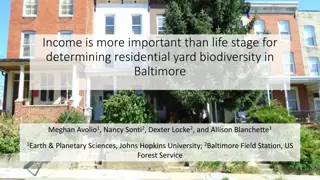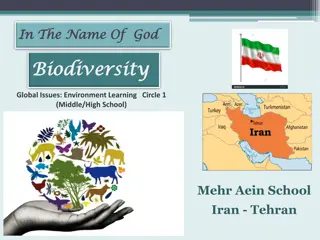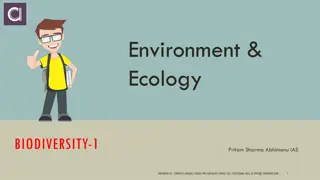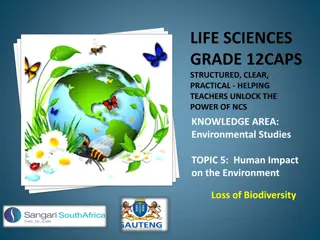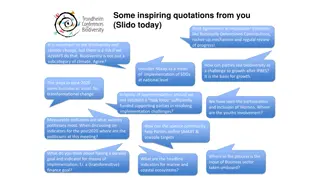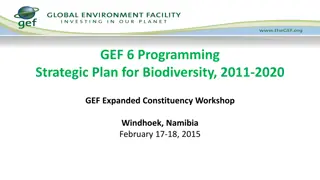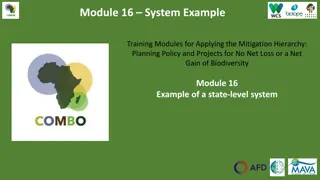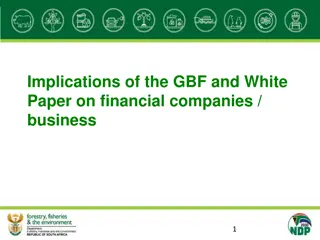Development of Post-2020 Global Biodiversity Framework Update
This content discusses the process and updated draft of the Post-2020 Global Biodiversity Framework, highlighting the roles of subsidiary bodies, key recommendations, and the preparation of Draft 1.0. It outlines the involvement of SBSTTA, SBI, and OEWG committees, as well as the thematic areas and advice provided for the CBD Post-2020 Process. The upcoming negotiations at WG2020-3 will be based on this framework.
Download Presentation

Please find below an Image/Link to download the presentation.
The content on the website is provided AS IS for your information and personal use only. It may not be sold, licensed, or shared on other websites without obtaining consent from the author.If you encounter any issues during the download, it is possible that the publisher has removed the file from their server.
You are allowed to download the files provided on this website for personal or commercial use, subject to the condition that they are used lawfully. All files are the property of their respective owners.
The content on the website is provided AS IS for your information and personal use only. It may not be sold, licensed, or shared on other websites without obtaining consent from the author.
E N D
Presentation Transcript
DEVELOPMENT OF POST-2020 GLOBAL BIODIVERSITY FRAMEWORK UPDATE ON PROCESS AND UPDATED ZERO DRAFT OEWG Co-Chairs 18 SEPTEMBER 2020 Francis Ogwal Basile van Havre Special Briefing Session
Presentation Plan 1. Process 2. Updated Zero Draft Planning assumptions Roles of subsidiary bodies and working group Key recommendations from OEWG2 meeting Preparation of Draft 1.0 CBD Post 2020 Process 2
1. Process Roles of Subsidiary Bodies & OEWG Committees: SBSTTA , SBI and OEWG: Each has Unique & Valuable roles E.g. SBSTTA is the only forum/opportunity to discuss science among experts Complementary roles E.g. for indicators: SBSTTA will discuss scientific validity then SBI will discuss how they will be implemented CBD Post 2020 Process Exclusive roles OEWG: Negotiation of Goals and Targets 3
1. Process Key Recommendations from WG2020-2 1. Co-Chairs to Prepare updated draft of the GBF based on Rome discussion: Posted September 1 - presented today SBSTTA to provide scientific and technical advice as per the mandates from COP, WG2020-1 and WG2020-2 (including, scientific advice numerical values, indicators, baselines) SBI to provide advice on implementation resource mobilization, capacity development, enabling conditions, knowledge management, outreach and awareness, responsibility and transparency Co-Chairs to prepare draft 1.0 in advance of WG2020-3 2. 3. CBD Post 2020 Process 4. 4
1. Process Draft 1.0 Will reflect WG2020-1 and WG2020-2 WG8j, SBSTTA-23, SBSTTA-24 and SBI-3 Written Submissions up to Feb 24, 2020 Thematic consultations and other Post-2020 meetings CBD Post 2020 Process Will be the basis for negotiations at WG2020-3 5
1. Process How Will Your Work be Included DSI Advice on 1. Numerical values 2. Indicators (headline) 3. Availability of baseline information SBSTTA Goals & Targets Thematics: Sustainable Use OEWG CoP Thematics: Synergies, ABS Advice on GBF language (principles) Implementation Support Resource Mobilization Capacity development Knowledge Enabling Conditions Responsibility & Transparency Outreach and Awareness CBD Post 2020 Process SBI CoP decision with details 6
2. Progress on Development of the Post- 2020 Global Biodiversity Framework CBD Post 2020 Process 7
2 Updated Zero Draft Key Updates Goals Combined Goals A B and C (now: all in Goal A) Shortened Goal D Added a Goal on Means of Implementation Added Milestones for each Goal Targets Added a species focused (now: Target 3) Tools and Solutions: Merger & Reordered for better flow Sections E to H (now: Sections F to I): Update to the whole section CBD Post 2020 Process 8
2 Updated Zero Draft II/B&D: Goals & Targets (Milestones) Milestones: Included in updated Zero Draft with the objectives of: Ensuring we are able to measure and show progress toward in 2030 milestones and 2050 Goals Ensuring we can evaluate if the Action Targets are the right tools to meet the 2050 Vision CBD Post 2020 Process 9
2 Updated Zero Draft II/B&D: Goals A & B Zero Draft Updated Zero Draft A No net loss in the area and integrity of freshwater, marine and terrestrial ecosystems A: The area, connectivity and integrity of natural ecosystems increased by at least [20%] supporting healthy and resilient populations of all species while reducing the number of species that are threatened by [X%] and maintaining genetic diversity. B The percentage of species threatened with extinction, is reduced by [X%] and the abundance of species has increased on average by [X%] 2030 Milestones a) The area, connectivity and integrity of natural ecosystems increased by at least [5%], which facilitates increased conservation and recovery of species, as well as the maintenance and/or increase in genetic diversity. b) The number of species that are threatened is reduced by [X%] and the abundance of species has increased on average by [X%] C Genetic diversity is maintained or enhanced on average D Nature provides benefits to people I. improvements in nutrition for at least [X million] people II. improvements in sustainable access to safe and drinkable water for at least [X million] people III. improvements in the resilience from natural disasters for at least [X million] people IV. at least [30%] of efforts to achieve the targets of the Paris Agreement B: Nature s contributions to people have been valued, maintained or enhanced through conservation and sustainable use supporting global development agenda for the benefit of all people CBD Post 2020 Process 2030 Milestones (a) Nature contribute to the sustainable nutrition, access to safe drinking water and resilience to natural disasters for at least (X million) people (b) Nature is valued through ecosystem service valuation and public and private sector disclosure
2 Updated Zero Draft II/B&D: Goals C & D Updated Zero Draft Zero Draft E The benefits, shared fairly and equitably, from the use of genetic resources and associated traditional knowledge, have increased by [X] C: The benefits, from utilization of genetic resources are shared fairly and equitably 2030 Milestone (a) Equitable systems for sharing benefits are established in all countries in order for the benefits to be shared fairly and equitably from the use of genetic resources and associated traditional knowledge. D: Means of implementation is available to achieve all goals and targets the Framework New request from WG2020-2 2030 Milestones (a) By 2022, resources and capacity have been identified/committed to implement the Framework for the period of 2020 to 2030, including the incorporation of traditional knowledge, science and technology, and monitoring. (b) By 2030, resources, and potential future resources, have been identified/committed by 2030 for the periods to 2040 and to 2050. CBD Post 2020 Process 11
2 Updated Zero Draft II/E: Reducing Threats: Targets 1-3 Updated Zero Draft Zero Draft 1 Retain and restore freshwater, marine and terrestrial ecosystems, by increasing at least [50%] of land and sea area under comprehensive spatial planning addressing land/sea use change, achieving a net increase in area, connectivity and integrity and retaining existing intact areas and wilderness T1: By 2030, [50%] of land and sea areas globally are under spatial planning addressing land/sea use change, retaining most of the existing intact and wilderness areas, and allow to restore [X%] of degraded freshwater, marine and terrestrial natural ecosystems and connectivity among them T2: By 2030, protect and conserve through well connected and effective system of protected areas and other effective area-based conservation measures at least 30% of the planet with the focus on areas particularly important for biodiversity 2 Protect sites of particular importance for biodiversity through protected areas and other effective area-based conservation measures, covering at least [60%] of such sites and at least [30%] of land and sea areas with at least [10%] under strict protection T3: By 2030, ensure active management actions to enable wild species of fauna and flora recovery and conservation, and reduce human-wildlife conflict by [X%] CBD Post 2020 Process New request from WG2020-2 12
2 Updated Zero Draft II/E: Reducing Threats: Targets 4-7 Zero Draft Updated Zero Draft 5 Ensure that the harvesting, trade and use of wild species, is legal and at sustainable levels T4: By 2030, ensure that the harvesting, trade and use of wild species of fauna and flora, is legal, at sustainable levels and safe. 3 Control all pathways for the introduction of invasive alien species achieving a [50%] reduction in the rate of new introductions, and eradicate or control invasive alien species to eliminate or reduce their impacts by 2030 in at least [50%] of priority sites T5: By 2030, manage, and where possible control, pathways for the introduction of IAS, achieving [50%] reduction in the rate of new introductions, and eradicate, control and manage IAS to eliminate or reduce their impacts, including in at least [50%] of priority sites 4 Reduce by at least [50%], pollution from excess nutrients, biocides, plastic waste and other sources T6: By 2030, reduce pollution from all sources, including reducing excess nutrients [by x%], biocides [by x%], plastic waste [by x%] to levels that are not harmful to biodiversity and ecosystem functions and human health 6 Contribute to climate change mitigation and adaptation and disaster risk reduction through nature-based solutions, providing [about 30%] [at least XXX MT CO2=] of the mitigation effort needed to achieve the goals of the Paris Agreement, complementing stringent emission reductions and avoiding negative impacts on biodiversity and food security CBD Post 2020 Process T7: By 2030, increase contributions to climate change mitigation adaption and disaster risk reduction from nature-based solutions and ecosystems based approached, ensuring resilience and minimizing any negative impacts on biodiversity 13
2 Updated Zero Draft II/E: Meeting Peoples Needs: Targets 8-9 Zero Draft Updated Zero Draft T8: By 2030, ensure benefits, including nutrition, food security, livelihoods, health and wellbeing, for people, especially for the most vulnerable through sustainable management of wild species of fauna and flora 7 Enhance the sustainable use of wild species providing, benefits, including enhanced nutrition, food security and livelihoods for at least [X million] people, especially for the most vulnerable, and reduce human- wildlife conflict by [X%] T9: By 2030, support the productivity, sustainability and resilience of biodiversity in agricultural and other managed ecosystems through conservation and sustainable use of such ecosystems, reducing productivity gaps by at least [50%] 8 Conserve and enhance the sustainable use of biodiversity in agricultural and other managed ecosystems to support the productivity, sustainability and resilience of such systems, reducing related productivity gaps by at least [50%] CBD Post 2020 Process 14
2 Updated Zero Draft II/E: Meeting Peoples Needs: Targets 10-12 Zero Draft Updated Zero Draft 9 Enhance nature-based solutions contributing, to clean water provision for at least [XXX million] people T10: By 2030, ensure that, nature based solutions and ecosystem approach contribute to regulation of air quality, hazards and extreme events and quality and quantity of water for at least [XXX million] people 10 Enhance the benefits of green spaces for health and well-being, especially for urban dwellers, increasing the proportion of people with access to such spaces by at least [100%] T11: By 2030, increase benefits from biodiversity and green/blue spaces for human health and well-being, including the proportion of people with access to such spaces by at least [100%], especially for urban dwellers T12: By 2030, increase by [X] benefits shared for the conservation and sustainable use of biodiversity through ensuring access to and the fair and equitable sharing of benefits arising from utilization of genetic resources and associated traditional knowledge 11 Ensure that benefits from the utilization of genetic resources, and related traditional knowledge, are shared fairly and equitably, resulting in an [X] increase of benefits CBD Post 2020 Process 15
2 Updated Zero Draft II/E: Tools & Solutions Targets 15-16 Zero Draft Updated Zero Draft 17 People everywhere take measurable steps towards sustainable consumption and lifestyles, taking into account individual and national cultural and socioeconomic conditions, achieving just and sustainable consumption levels T15: By 2030, eliminate unsustainable consumption patterns, ensuring people everywhere understand and appreciate the value of biodiversity, make responsible choices commensurate with 2050 biodiversity vision, taking into account individual and national cultural and socioeconomic conditions 18 Promote education and the generation, sharing and use of knowledge relating to biodiversity, in the case of the traditional knowledge, innovations and practices of indigenous and local communities with their free, prior and informed consent, ensuring that all decision makers have access to reliable and up-to- date information for the effective management of biodiversity T16: By 2030, establish and implement measures to prevent, manage or control potential adverse impacts of biotechnology on biodiversity and human health reducing these impacts by [X] 16 Establish and implement measures in all countries to prevent potential adverse impacts of biotechnology on biodiversity CBD Post 2020 Process 16
2 Updated Zero Draft II/F: Implementation Support Mechanisms Mobilizing Sufficient Resources An enhanced financial mechanism that delivers resources for developing countries; Reducing or redirecting resources causing harm to biodiversity; Generating additional financial and non-financial resources from all sources, including from international and domestic sources and the public and private sectors; Enhancing the effectiveness and efficiency of resource use; National finance plans to support implementation. Capacity Development Enabling evidence-based implementation through nationally determined and/or country-driven actions, in accordance with national priorities; Support to government and non-government actors at all levels, particularly in developing countries and countries with economies in transition, to develop, utilize and retain requisite capacities and to learn, adapt and manage change; CBD Post 2020 Process Building capacities at the individual, organizational and enabling environment levels to facilitate effective policy formulation, the mainstreaming of biodiversity into all sectors, implementation of the framework and the establishment of national systems and measures for transparency and reporting. 17
2 Updated Zero Draft II/F: Implementation Support Mechanisms Knowledge generation, management and sharing Greater protection of traditional knowledge and recognition of its contributions to the conservation and sustainable use of biodiversity; Promotion of biodiversity science and education and organizational learning. Technical and scientific cooperation, technology transfer and innovation Support mechanisms for technical and scientific cooperation, technology transfer and innovation on mutually agreed terms; Support for cooperation amongst developing countries and with developed countries CBD Post 2020 Process 18
2 Updated Zero Draft II/G Enabling Conditions The participation of IPLCs and a recognition of their rights in the implementation of the framework The participation of all relevant stakeholders, NGOs, youth, civil society, local and subnational authorities, the private sector, academia and scientific institutions Gender equality, gender-responsive approaches and empowerment of women and girls Recognition of intergenerational equity Synergies among relevant MEAs and other relevant international processes, including the 2030 Agenda for Sustainable Development Partnerships to leverage sustainable activities and programmes at the local, national, regional and global levels CBD Post 2020 Process 19
2 Updated Zero Draft II/G Enabling Conditions Inclusive and integrative governance Mainstreaming biodiversity in all sectors The engagement of private sector, academic institutions and civil societies Safety and security in use of biodiversity to prevent spillover of zoonotic diseases, spread of invasive alien species and illegal trade in wildlife Political will and recognition at the highest levels of government of the urgent need to halt biodiversity loss The active involvement of subnational governments, cities and other local authorities and a recognition of their competence and specific roles for the implementation of the framework Consider and recognize, where appropriate, the rights of nature CBD Post 2020 Process 20
2 Updated Zero Draft II/H: Responsibility & Transparency The successful implementation of the framework is dependent on the use of a comprehensive system for planning, reporting and review. This system minimizes the burden on Parties, the Secretariat and other entities. It is aligned with, and where appropriate integrated with other processes including Agenda 2030 and the Sustainable Development Goals. The system will be complemented by the systems of non- State actors, and the development of new systems or the adaptation of existing ones is encouraged. CBD Post 2020 Process 21
2 Updated Zero Draft II/H: Responsibility & Transparency The system for planning, reporting and review for national government entities includes the following elements: (a) Planning National strategies and action plans: Are the main instrument to identify national commitments Include all targets and actions Address all performance indicators relevant to the identified targets drawing on the monitoring framework attached to this framework Should include a financing plan Should be updated quickly according to an agreed schedule. Indicatorswill be an important part of planning and reporting process including Headline indicators Planning documents will be updated on a continuous basis CBD Post 2020 Process 22
2 Updated Zero Draft II/H: Responsibility & Transparency (b) Reporting National reports Report on all actions using agreed indicators Will be issued regularly and in time Global reports / Global stocktake Global collation of statistical information Takes place frequently Reporting schedule used regularly Global assessment processes Including GBO and IPBES processes will be reviewed for efficiency and complementarity and timeliness CBD Post 2020 Process 23
2 Updated Zero Draft II/H: Responsibility & Transparency (c) Review: Three Tools Global analysis of progress on objective/numerical elements of targets and progress towards milestones and goals; Open ended Forums for the review of national implementation and to share lessons learned and best practices; Voluntary in-depth peer review of national implementation by experts including from other parties. CBD Post 2020 Process 24
Thank You UN BIODIVERSITY CONFERENCE UN BIODIVERSITY CONFERENCE COP 15 CP/MOP10-NP/MOP4 Ecological Civilization-Building a Shared Future for All Life on Earth CBD Post 2020 Process KUNMING CHINA #Post2020 #Nature
Annex: Updated Zero Draft CBD Post 2020 Process 26
3. Next Steps Moving Forward June Aug Jul Oct TBC Sept Synergies Final Draft Webinar Draft 1.0 COP 15 OEWG-3 Them. SBSTTA Sust Use Them. Sp. Sessions Them. DSI ABS DSI Docs Docs GBO-5 Review Mechanisms Resource Mobilization Post-2020 Rev. SBSTTA docs Annotations SDG linkages Advice on numerical targets CBD Post 2020 Process Complete Updated draft (incl: Goals, Milestones, Targets, & Sections E to H) SBI docs SBI-3 27
2 Updated Zero Draft Part I, Part II Sections A & C Part I Sections A & B: Not discussed in Rome: No changes Section C: Theory of Change: Goals updated CBD Post 2020 Process Part II Section A Vision: No changes Section C Mission: Not discussed in Rome: No changes 28
2 Updated Zero Draft Goals and Targets Resource Mobilization, Capacity Building, Technology Transfer, Traditional Knowledge Means of Implementation Reducing Threats 2050 Goals 2030 Milestones 2050 Vision Tools & Solutions Reducing Threats 1. Land/Sea Plan, Retain, Restore (a) Ecosystems, Species and Genetic Diversity New/reorder in red 2. Land/Sea Protect, Conserve i) Area, connectivity & integrity of natural ecosystems increased by at least [5%] 3. Species Recovery, Conservation ii) Number of threatened species reduced by [X%] & abundance of species increased by [X%] 4. Sustainable Harvest, Trade, Use 5. Invasive Alien Species 13 (was 14). Mainstream in Policies, Planning, Regulation Living in Harmony with Nature 6. Pollution (b) Nature s Contributions to People 14 (15). Mainstream in Production and Supply Chains 7. Climate Change i) Contribute to nutrition & food security, access to safe drinking water & resilience to natural disasters for at least [X] million people ii) Nature is valued through green investments, ecosystem service valuation, financial disclosure 15 (18). Sustainable Consumption - Responsible Choices Meeting Peoples Needs 8. Use of Species (Fishery ) 16 (17). Biosafety 9. Use of Spaces (Agriculture ) 17 (13). Incentives & Subsidies 10. Other Regulating Services 18 (16). Resource Mobilization and Capacity Building CBD Post 2020 Process (c) Benefits Shared Fairly and Equitably Conditions 11. Health Culture Enabling 19. Information Available, including Traditional Knowledge 12. Benefits Sharing i) ABS mechanisms are established in all countries ii) Benefits shared increased by [x%] 20. IPLCs, Women & Girls, Youth (d) Means of Implementation Responsibility & Transparency Planning, Reporting, Review, Additional Mechanisms i) By 2022, means to implement to 2030 ii) By 2030, means to implement to 2040
2 Updated Zero Draft II/E: Tools & Solutions: Targets 13-14 Updated Zero Draft Zero Draft 13 Integrate biodiversity values into national and local planning, development processes, poverty reduction strategies and accounts, ensuring that biodiversity values are mainstreamed across all sectors and that biodiversity-inclusive strategic impact assessments and environmental impact assessments are comprehensively applied T13: By 2030, integrate biodiversity values into policies, regulations, planning, development processes, poverty reduction strategies and accounts at all levels, ensuring that biodiversity values are mainstreamed across all sectors and integrated into assessments of environmental impacts 14 Reform economic sectors towards sustainable practices, including along their national and transnational supply chains, achieving a reduction of at least [50%] in negative impacts on biodiversity T14: By 2030, achieve reduction of at least [50%] in negative impacts on biodiversity by ensuring production practices and supply chains are sustainable CBD Post 2020 Process 30
2 Updated Zero Draft II/E: Tools & Solutions: Targets 17-20 Updated Zero Draft Zero Draft 12 Reform incentives, eliminating the subsidies most harmful for biodiversity, ensuring, that incentives, including public and private economic and regulatory incentives, are either positive or neutral for biodiversity T17: By 2030, redirect, repurpose, reform or eliminate incentives harmful for biodiversity, including [X] reduction in the most harmful subsidies, ensuring that incentives, including public and private economic and regulatory incentives, are either positive or neutral for biodiversity 15 Resources, including capacity-building, for implementing the framework have increased from all sources so that resources have increased by [X%] and are commensurate with the ambition of the targets of the framework T18: By 2030, increase by [X%] financial resources from all international and domestic sources, through new, additional and effective financial resources commensurate with the ambition of the goals and targets of the Framework and implement the strategy for capacity-building and technology transfer and scientific cooperation to meet the needs for implementing the post2020 global biodiversity framework CBD Post 2020 Process 31
2 Updated Zero Draft II/E: Tools & Solutions: Targets 17-20 Zero Draft Updated Zero Draft 19 Promote the full and effective participation of indigenous peoples and local communities, and of women and girls as well as youth, in decision-making related to the conservation and sustainable use of biodiversity, ensuring equitable participation and rights over relevant resources T19: By 2030, ensure that quality information, including traditional knowledge, is available to decision makers and public for the effective management of biodiversity through promoting awareness, education and research T20: By 2030, ensure equitable participation in decision- making related to biodiversity and ensure rights over relevant resources of indigenous peoples and local communities, women and girls as well as youth, in accordance with national circumstances 20 Foster diverse visions of good quality of life and unleash values of responsibility, to effect new social norms for sustainability CBD Post 2020 Process 32
2 Updated Zero Draft II/I: Outreach, Awareness and Uptake Increasing understanding, awareness and appreciation of the values of biodiversity including the associated knowledge, values and approaches used by IPLCs Raising awareness of all actors of the existence of the goals and targets of the post-2020 global biodiversity framework and progress made towards their achievement; CBD Post 2020 Process Promoting or developing platforms and partnerships, including with media and civil society to share information on successes, lessons learned and experiences in acting for biodiversity 33
Resource Mobilization, Capacity Building, Technology Transfer, Traditional Knowledge GBF: Updated Zero Draft Means of Implementation 2050 Goals 2030 Milestones 2050 Vision Tools & Solutions Reducing Threats 1. Land/Sea Plan, Retain, Restore 2. Land/Sea Protect, Conserve 3. Species Recovery, Conservation 13 . Mainstream in Policies, Planning, Regulation (a) Ecosystems, Species and Genetic Diversity 4. Sustainable Harvest, Trade, Use Living in Harmony with Nature 14. Mainstream in Production and Supply Chains 5. Invasive Alien Species 15. Sustainable Consumption - Responsible Choices 6. Pollution 7. Climate Change 16. Biotechnology & Biosafety Meeting Peoples Needs 17. Incentives & Subsidies 18. Resource Mobilization and Capacity Building 8. Use of Species (Fishery ) Enabling Conditions 9. Use of Spaces (Agriculture ) (b) Nature s Contributions to People 19. Information Available, including Traditional Knowledge 10. Other Regulating Services CBD Post 2020 Process 20. IPLCs, Women & Girls, Youth 11. Health Culture (c) Benefits Shared Fairly and Equitably 12. Benefits Sharing (d) Means of Implementation Responsibility & Transparency Planning, Reporting, Review, Additional Mechanisms
